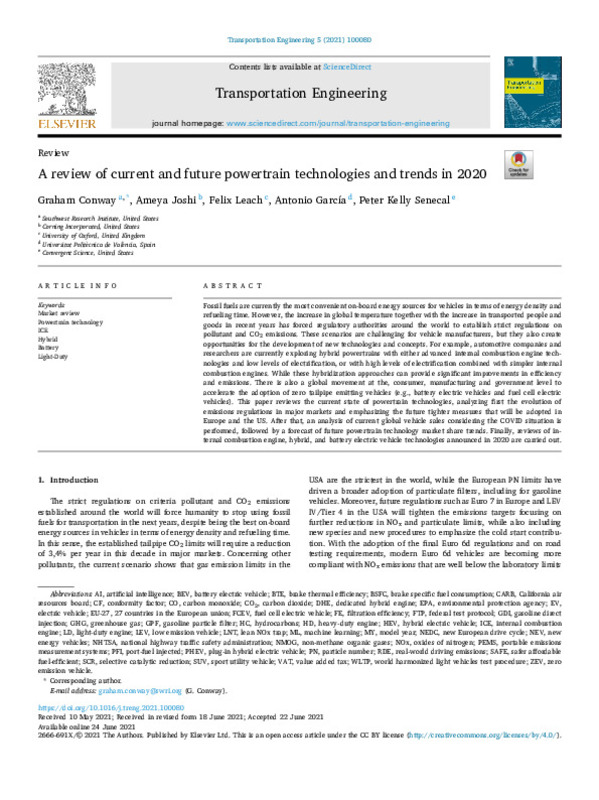JavaScript is disabled for your browser. Some features of this site may not work without it.
Buscar en RiuNet
Listar
Mi cuenta
Estadísticas
Ayuda RiuNet
Admin. UPV
A review of current and future powertrain technologies and trends in 2020
Mostrar el registro sencillo del ítem
Ficheros en el ítem
| dc.contributor.author | Conway, Graham
|
es_ES |
| dc.contributor.author | Joshi, Ameya
|
es_ES |
| dc.contributor.author | Leach, Felix
|
es_ES |
| dc.contributor.author | García Martínez, Antonio
|
es_ES |
| dc.contributor.author | Senecal, Peter Kelly
|
es_ES |
| dc.date.accessioned | 2022-11-07T16:34:32Z | |
| dc.date.available | 2022-11-07T16:34:32Z | |
| dc.date.issued | 2021-09 | es_ES |
| dc.identifier.uri | http://hdl.handle.net/10251/189354 | |
| dc.description.abstract | [EN] Fossil fuels are currently the most convenient on-board energy sources for vehicles in terms of energy density and refueling time. However, the increase in global temperature together with the increase in transported people and goods in recent years has forced regulatory authorities around the world to establish strict regulations on pollutant and CO2 emissions. These scenarios are challenging for vehicle manufacturers, but they also create opportunities for the development of new technologies and concepts. For example, automotive companies and researchers are currently exploring hybrid powertrains with either advanced internal combustion engine technologies and low levels of electrification, or with high levels of electrification combined with simpler internal combustion engines. While these hybridization approaches can provide significant improvements in efficiency and emissions. There is also a global movement at the, consumer, manufacturing and government level to accelerate the adoption of zero tailpipe emitting vehicles (e.g., battery electric vehicles and fuel cell electric vehicles). This paper reviews the current state of powertrain technologies, analyzing first the evolution of emissions regulations in major markets and emphasizing the future tighter measures that will be adopted in Europe and the US. After that, an analysis of current global vehicle sales considering the COVID situation is performed, followed by a forecast of future powertrain technology market share trends. Finally, reviews of internal combustion engine, hybrid, and battery electric vehicle technologies announced in 2020 are carried out. | es_ES |
| dc.language | Inglés | es_ES |
| dc.publisher | Elsevier | es_ES |
| dc.relation.ispartof | Transportation Engineering | es_ES |
| dc.rights | Reconocimiento (by) | es_ES |
| dc.subject | Market review | es_ES |
| dc.subject | Powertrain technology | es_ES |
| dc.subject | ICE | es_ES |
| dc.subject | Hybrid | es_ES |
| dc.subject | Battery | es_ES |
| dc.subject | Light-Duty | es_ES |
| dc.title | A review of current and future powertrain technologies and trends in 2020 | es_ES |
| dc.type | Artículo | es_ES |
| dc.identifier.doi | 10.1016/j.treng.2021.100080 | es_ES |
| dc.rights.accessRights | Abierto | es_ES |
| dc.description.bibliographicCitation | Conway, G.; Joshi, A.; Leach, F.; García Martínez, A.; Senecal, PK. (2021). A review of current and future powertrain technologies and trends in 2020. Transportation Engineering. 5:1-15. https://doi.org/10.1016/j.treng.2021.100080 | es_ES |
| dc.description.accrualMethod | S | es_ES |
| dc.relation.publisherversion | https://doi.org/10.1016/j.treng.2021.100080 | es_ES |
| dc.description.upvformatpinicio | 1 | es_ES |
| dc.description.upvformatpfin | 15 | es_ES |
| dc.type.version | info:eu-repo/semantics/publishedVersion | es_ES |
| dc.description.volume | 5 | es_ES |
| dc.identifier.eissn | 2666-691X | es_ES |
| dc.relation.pasarela | S\446686 | es_ES |








